Strategic Marketing: Tesco's Corporate and Marketing Strategies
VerifiedAdded on 2019/12/03
|27
|10533
|152
Report
AI Summary
This report provides a detailed analysis of strategic marketing, with a specific focus on the retail giant Tesco. It begins by defining strategic marketing and its role within an organization, emphasizing its integration with business strategy. The report then delves into Tesco's internal and external environmental analysis, evaluating various approaches and their integration. It explores corporate-level decisions, their impact on marketing functions, and approaches to competitive positioning. Furthermore, the report examines strategies for gaining a competitive advantage, marketing communication strategies, and the implementation of these marketing strategies within Tesco. The study highlights Tesco's use of strategic marketing to build customer relationships, increase market share, and establish a strong brand identity, particularly through initiatives like the Clubcard strategy. The report underscores the importance of aligning corporate and marketing strategies for business success, as well as the steps involved in developing an effective marketing strategy, including goal setting, market research, competitor analysis, and strategy development. The report concludes by emphasizing the dynamic nature of the retail industry and the need for companies like Tesco to adopt effective marketing approaches to maintain awareness and attract customers.
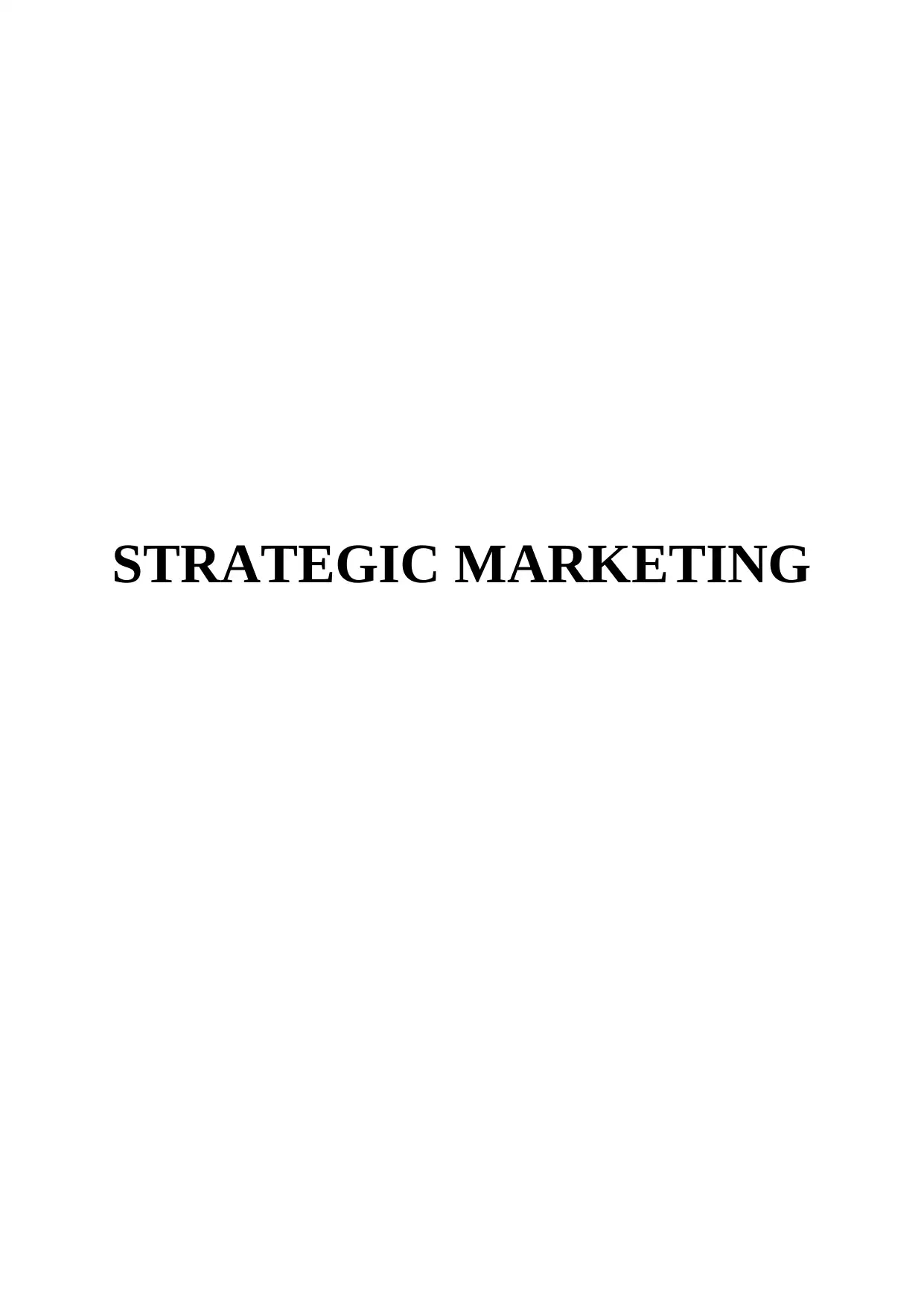
STRATEGIC MARKETING
Paraphrase This Document
Need a fresh take? Get an instant paraphrase of this document with our AI Paraphraser
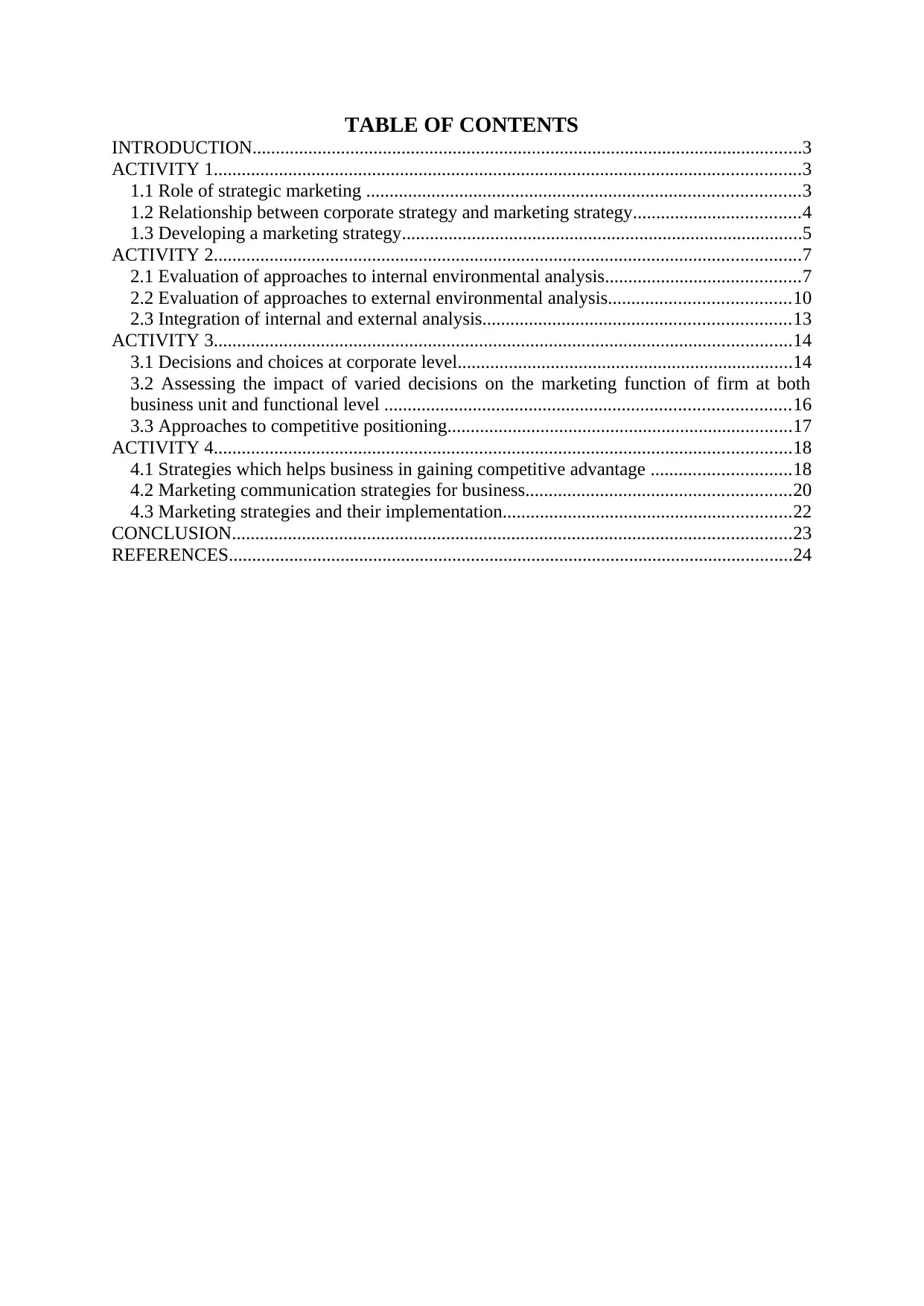
TABLE OF CONTENTS
INTRODUCTION......................................................................................................................3
ACTIVITY 1..............................................................................................................................3
1.1 Role of strategic marketing .............................................................................................3
1.2 Relationship between corporate strategy and marketing strategy....................................4
1.3 Developing a marketing strategy......................................................................................5
ACTIVITY 2..............................................................................................................................7
2.1 Evaluation of approaches to internal environmental analysis..........................................7
2.2 Evaluation of approaches to external environmental analysis.......................................10
2.3 Integration of internal and external analysis..................................................................13
ACTIVITY 3............................................................................................................................14
3.1 Decisions and choices at corporate level........................................................................14
3.2 Assessing the impact of varied decisions on the marketing function of firm at both
business unit and functional level .......................................................................................16
3.3 Approaches to competitive positioning..........................................................................17
ACTIVITY 4............................................................................................................................18
4.1 Strategies which helps business in gaining competitive advantage ..............................18
4.2 Marketing communication strategies for business.........................................................20
4.3 Marketing strategies and their implementation..............................................................22
CONCLUSION........................................................................................................................23
REFERENCES.........................................................................................................................24
INTRODUCTION......................................................................................................................3
ACTIVITY 1..............................................................................................................................3
1.1 Role of strategic marketing .............................................................................................3
1.2 Relationship between corporate strategy and marketing strategy....................................4
1.3 Developing a marketing strategy......................................................................................5
ACTIVITY 2..............................................................................................................................7
2.1 Evaluation of approaches to internal environmental analysis..........................................7
2.2 Evaluation of approaches to external environmental analysis.......................................10
2.3 Integration of internal and external analysis..................................................................13
ACTIVITY 3............................................................................................................................14
3.1 Decisions and choices at corporate level........................................................................14
3.2 Assessing the impact of varied decisions on the marketing function of firm at both
business unit and functional level .......................................................................................16
3.3 Approaches to competitive positioning..........................................................................17
ACTIVITY 4............................................................................................................................18
4.1 Strategies which helps business in gaining competitive advantage ..............................18
4.2 Marketing communication strategies for business.........................................................20
4.3 Marketing strategies and their implementation..............................................................22
CONCLUSION........................................................................................................................23
REFERENCES.........................................................................................................................24
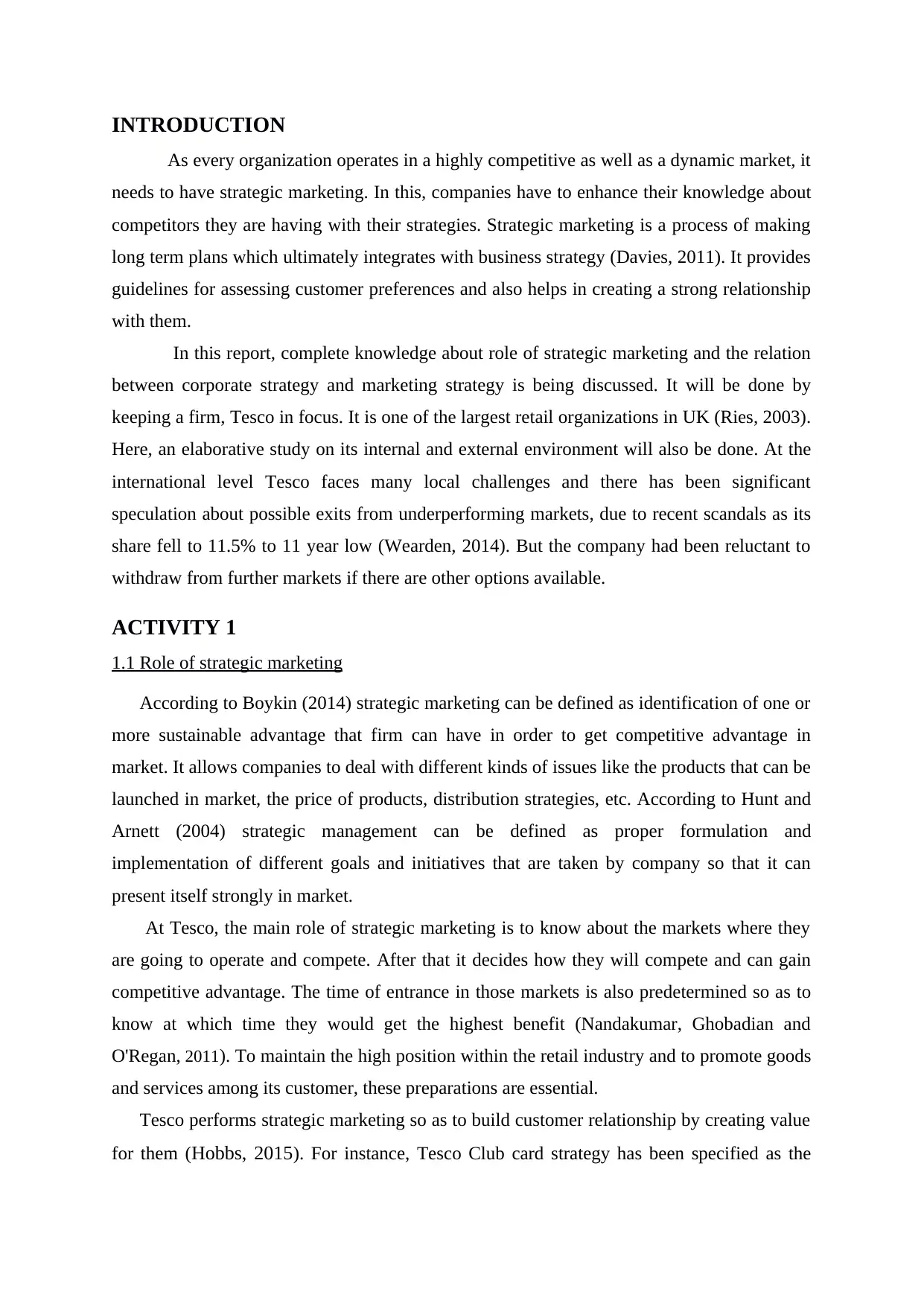
INTRODUCTION
As every organization operates in a highly competitive as well as a dynamic market, it
needs to have strategic marketing. In this, companies have to enhance their knowledge about
competitors they are having with their strategies. Strategic marketing is a process of making
long term plans which ultimately integrates with business strategy (Davies, 2011). It provides
guidelines for assessing customer preferences and also helps in creating a strong relationship
with them.
In this report, complete knowledge about role of strategic marketing and the relation
between corporate strategy and marketing strategy is being discussed. It will be done by
keeping a firm, Tesco in focus. It is one of the largest retail organizations in UK (Ries, 2003).
Here, an elaborative study on its internal and external environment will also be done. At the
international level Tesco faces many local challenges and there has been significant
speculation about possible exits from underperforming markets, due to recent scandals as its
share fell to 11.5% to 11 year low (Wearden, 2014). But the company had been reluctant to
withdraw from further markets if there are other options available.
ACTIVITY 1
1.1 Role of strategic marketing
According to Boykin (2014) strategic marketing can be defined as identification of one or
more sustainable advantage that firm can have in order to get competitive advantage in
market. It allows companies to deal with different kinds of issues like the products that can be
launched in market, the price of products, distribution strategies, etc. According to Hunt and
Arnett (2004) strategic management can be defined as proper formulation and
implementation of different goals and initiatives that are taken by company so that it can
present itself strongly in market.
At Tesco, the main role of strategic marketing is to know about the markets where they
are going to operate and compete. After that it decides how they will compete and can gain
competitive advantage. The time of entrance in those markets is also predetermined so as to
know at which time they would get the highest benefit (Nandakumar, Ghobadian and
O'Regan, 2011). To maintain the high position within the retail industry and to promote goods
and services among its customer, these preparations are essential.
Tesco performs strategic marketing so as to build customer relationship by creating value
for them (Hobbs, 2015). For instance, Tesco Club card strategy has been specified as the
As every organization operates in a highly competitive as well as a dynamic market, it
needs to have strategic marketing. In this, companies have to enhance their knowledge about
competitors they are having with their strategies. Strategic marketing is a process of making
long term plans which ultimately integrates with business strategy (Davies, 2011). It provides
guidelines for assessing customer preferences and also helps in creating a strong relationship
with them.
In this report, complete knowledge about role of strategic marketing and the relation
between corporate strategy and marketing strategy is being discussed. It will be done by
keeping a firm, Tesco in focus. It is one of the largest retail organizations in UK (Ries, 2003).
Here, an elaborative study on its internal and external environment will also be done. At the
international level Tesco faces many local challenges and there has been significant
speculation about possible exits from underperforming markets, due to recent scandals as its
share fell to 11.5% to 11 year low (Wearden, 2014). But the company had been reluctant to
withdraw from further markets if there are other options available.
ACTIVITY 1
1.1 Role of strategic marketing
According to Boykin (2014) strategic marketing can be defined as identification of one or
more sustainable advantage that firm can have in order to get competitive advantage in
market. It allows companies to deal with different kinds of issues like the products that can be
launched in market, the price of products, distribution strategies, etc. According to Hunt and
Arnett (2004) strategic management can be defined as proper formulation and
implementation of different goals and initiatives that are taken by company so that it can
present itself strongly in market.
At Tesco, the main role of strategic marketing is to know about the markets where they
are going to operate and compete. After that it decides how they will compete and can gain
competitive advantage. The time of entrance in those markets is also predetermined so as to
know at which time they would get the highest benefit (Nandakumar, Ghobadian and
O'Regan, 2011). To maintain the high position within the retail industry and to promote goods
and services among its customer, these preparations are essential.
Tesco performs strategic marketing so as to build customer relationship by creating value
for them (Hobbs, 2015). For instance, Tesco Club card strategy has been specified as the
⊘ This is a preview!⊘
Do you want full access?
Subscribe today to unlock all pages.

Trusted by 1+ million students worldwide
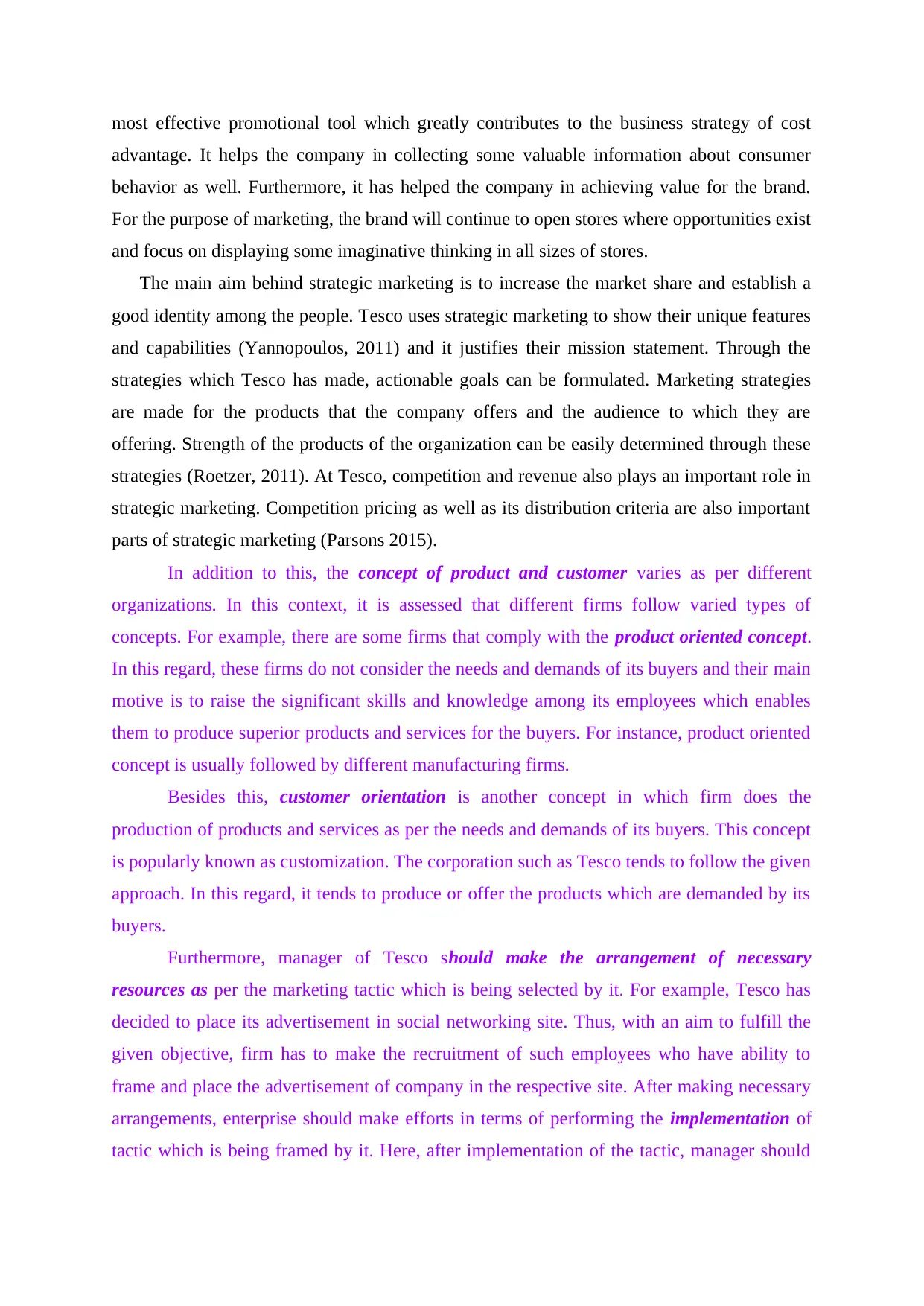
most effective promotional tool which greatly contributes to the business strategy of cost
advantage. It helps the company in collecting some valuable information about consumer
behavior as well. Furthermore, it has helped the company in achieving value for the brand.
For the purpose of marketing, the brand will continue to open stores where opportunities exist
and focus on displaying some imaginative thinking in all sizes of stores.
The main aim behind strategic marketing is to increase the market share and establish a
good identity among the people. Tesco uses strategic marketing to show their unique features
and capabilities (Yannopoulos, 2011) and it justifies their mission statement. Through the
strategies which Tesco has made, actionable goals can be formulated. Marketing strategies
are made for the products that the company offers and the audience to which they are
offering. Strength of the products of the organization can be easily determined through these
strategies (Roetzer, 2011). At Tesco, competition and revenue also plays an important role in
strategic marketing. Competition pricing as well as its distribution criteria are also important
parts of strategic marketing (Parsons 2015).
In addition to this, the concept of product and customer varies as per different
organizations. In this context, it is assessed that different firms follow varied types of
concepts. For example, there are some firms that comply with the product oriented concept.
In this regard, these firms do not consider the needs and demands of its buyers and their main
motive is to raise the significant skills and knowledge among its employees which enables
them to produce superior products and services for the buyers. For instance, product oriented
concept is usually followed by different manufacturing firms.
Besides this, customer orientation is another concept in which firm does the
production of products and services as per the needs and demands of its buyers. This concept
is popularly known as customization. The corporation such as Tesco tends to follow the given
approach. In this regard, it tends to produce or offer the products which are demanded by its
buyers.
Furthermore, manager of Tesco should make the arrangement of necessary
resources as per the marketing tactic which is being selected by it. For example, Tesco has
decided to place its advertisement in social networking site. Thus, with an aim to fulfill the
given objective, firm has to make the recruitment of such employees who have ability to
frame and place the advertisement of company in the respective site. After making necessary
arrangements, enterprise should make efforts in terms of performing the implementation of
tactic which is being framed by it. Here, after implementation of the tactic, manager should
advantage. It helps the company in collecting some valuable information about consumer
behavior as well. Furthermore, it has helped the company in achieving value for the brand.
For the purpose of marketing, the brand will continue to open stores where opportunities exist
and focus on displaying some imaginative thinking in all sizes of stores.
The main aim behind strategic marketing is to increase the market share and establish a
good identity among the people. Tesco uses strategic marketing to show their unique features
and capabilities (Yannopoulos, 2011) and it justifies their mission statement. Through the
strategies which Tesco has made, actionable goals can be formulated. Marketing strategies
are made for the products that the company offers and the audience to which they are
offering. Strength of the products of the organization can be easily determined through these
strategies (Roetzer, 2011). At Tesco, competition and revenue also plays an important role in
strategic marketing. Competition pricing as well as its distribution criteria are also important
parts of strategic marketing (Parsons 2015).
In addition to this, the concept of product and customer varies as per different
organizations. In this context, it is assessed that different firms follow varied types of
concepts. For example, there are some firms that comply with the product oriented concept.
In this regard, these firms do not consider the needs and demands of its buyers and their main
motive is to raise the significant skills and knowledge among its employees which enables
them to produce superior products and services for the buyers. For instance, product oriented
concept is usually followed by different manufacturing firms.
Besides this, customer orientation is another concept in which firm does the
production of products and services as per the needs and demands of its buyers. This concept
is popularly known as customization. The corporation such as Tesco tends to follow the given
approach. In this regard, it tends to produce or offer the products which are demanded by its
buyers.
Furthermore, manager of Tesco should make the arrangement of necessary
resources as per the marketing tactic which is being selected by it. For example, Tesco has
decided to place its advertisement in social networking site. Thus, with an aim to fulfill the
given objective, firm has to make the recruitment of such employees who have ability to
frame and place the advertisement of company in the respective site. After making necessary
arrangements, enterprise should make efforts in terms of performing the implementation of
tactic which is being framed by it. Here, after implementation of the tactic, manager should
Paraphrase This Document
Need a fresh take? Get an instant paraphrase of this document with our AI Paraphraser
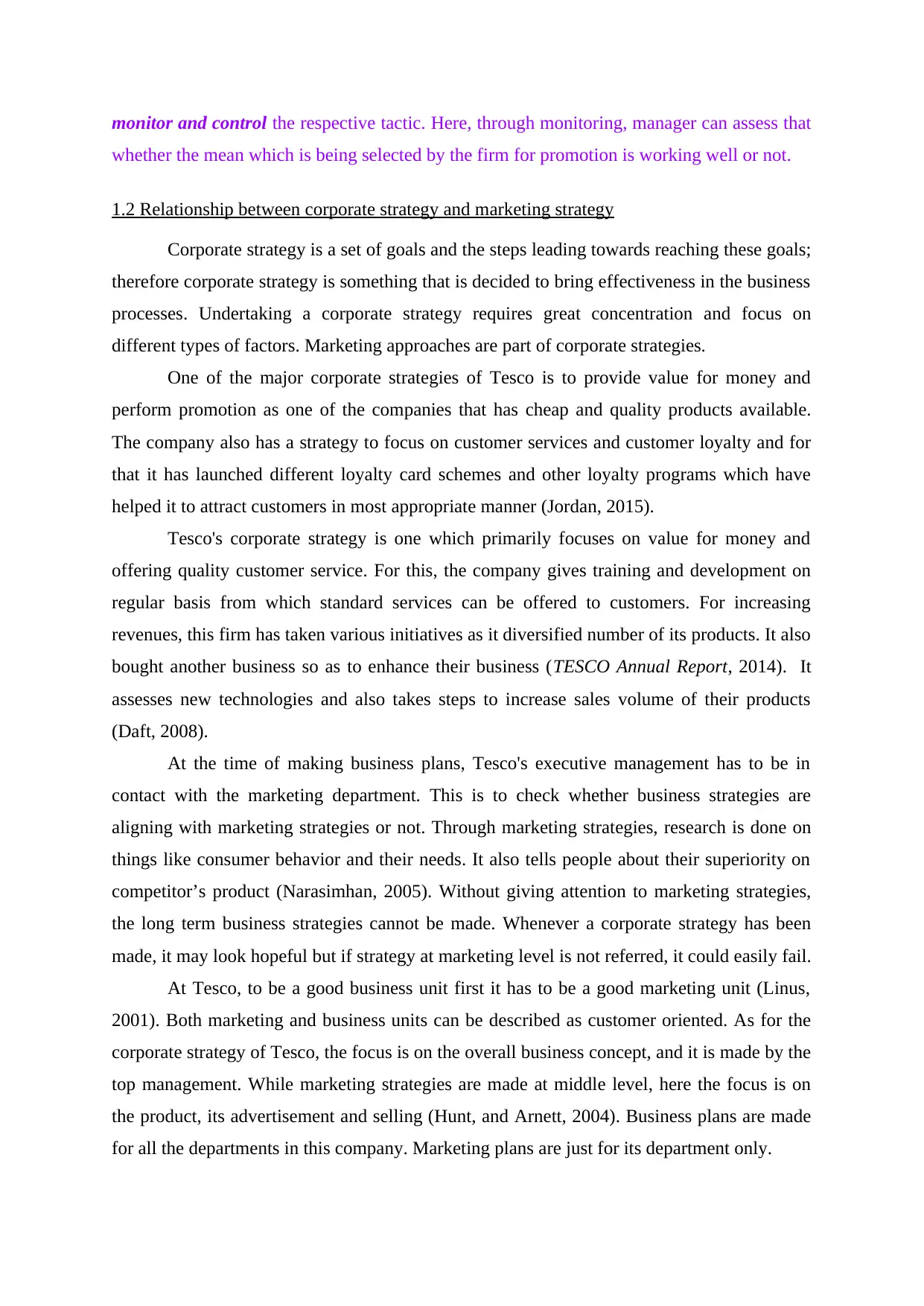
monitor and control the respective tactic. Here, through monitoring, manager can assess that
whether the mean which is being selected by the firm for promotion is working well or not.
1.2 Relationship between corporate strategy and marketing strategy
Corporate strategy is a set of goals and the steps leading towards reaching these goals;
therefore corporate strategy is something that is decided to bring effectiveness in the business
processes. Undertaking a corporate strategy requires great concentration and focus on
different types of factors. Marketing approaches are part of corporate strategies.
One of the major corporate strategies of Tesco is to provide value for money and
perform promotion as one of the companies that has cheap and quality products available.
The company also has a strategy to focus on customer services and customer loyalty and for
that it has launched different loyalty card schemes and other loyalty programs which have
helped it to attract customers in most appropriate manner (Jordan, 2015).
Tesco's corporate strategy is one which primarily focuses on value for money and
offering quality customer service. For this, the company gives training and development on
regular basis from which standard services can be offered to customers. For increasing
revenues, this firm has taken various initiatives as it diversified number of its products. It also
bought another business so as to enhance their business (TESCO Annual Report, 2014). It
assesses new technologies and also takes steps to increase sales volume of their products
(Daft, 2008).
At the time of making business plans, Tesco's executive management has to be in
contact with the marketing department. This is to check whether business strategies are
aligning with marketing strategies or not. Through marketing strategies, research is done on
things like consumer behavior and their needs. It also tells people about their superiority on
competitor’s product (Narasimhan, 2005). Without giving attention to marketing strategies,
the long term business strategies cannot be made. Whenever a corporate strategy has been
made, it may look hopeful but if strategy at marketing level is not referred, it could easily fail.
At Tesco, to be a good business unit first it has to be a good marketing unit (Linus,
2001). Both marketing and business units can be described as customer oriented. As for the
corporate strategy of Tesco, the focus is on the overall business concept, and it is made by the
top management. While marketing strategies are made at middle level, here the focus is on
the product, its advertisement and selling (Hunt, and Arnett, 2004). Business plans are made
for all the departments in this company. Marketing plans are just for its department only.
whether the mean which is being selected by the firm for promotion is working well or not.
1.2 Relationship between corporate strategy and marketing strategy
Corporate strategy is a set of goals and the steps leading towards reaching these goals;
therefore corporate strategy is something that is decided to bring effectiveness in the business
processes. Undertaking a corporate strategy requires great concentration and focus on
different types of factors. Marketing approaches are part of corporate strategies.
One of the major corporate strategies of Tesco is to provide value for money and
perform promotion as one of the companies that has cheap and quality products available.
The company also has a strategy to focus on customer services and customer loyalty and for
that it has launched different loyalty card schemes and other loyalty programs which have
helped it to attract customers in most appropriate manner (Jordan, 2015).
Tesco's corporate strategy is one which primarily focuses on value for money and
offering quality customer service. For this, the company gives training and development on
regular basis from which standard services can be offered to customers. For increasing
revenues, this firm has taken various initiatives as it diversified number of its products. It also
bought another business so as to enhance their business (TESCO Annual Report, 2014). It
assesses new technologies and also takes steps to increase sales volume of their products
(Daft, 2008).
At the time of making business plans, Tesco's executive management has to be in
contact with the marketing department. This is to check whether business strategies are
aligning with marketing strategies or not. Through marketing strategies, research is done on
things like consumer behavior and their needs. It also tells people about their superiority on
competitor’s product (Narasimhan, 2005). Without giving attention to marketing strategies,
the long term business strategies cannot be made. Whenever a corporate strategy has been
made, it may look hopeful but if strategy at marketing level is not referred, it could easily fail.
At Tesco, to be a good business unit first it has to be a good marketing unit (Linus,
2001). Both marketing and business units can be described as customer oriented. As for the
corporate strategy of Tesco, the focus is on the overall business concept, and it is made by the
top management. While marketing strategies are made at middle level, here the focus is on
the product, its advertisement and selling (Hunt, and Arnett, 2004). Business plans are made
for all the departments in this company. Marketing plans are just for its department only.
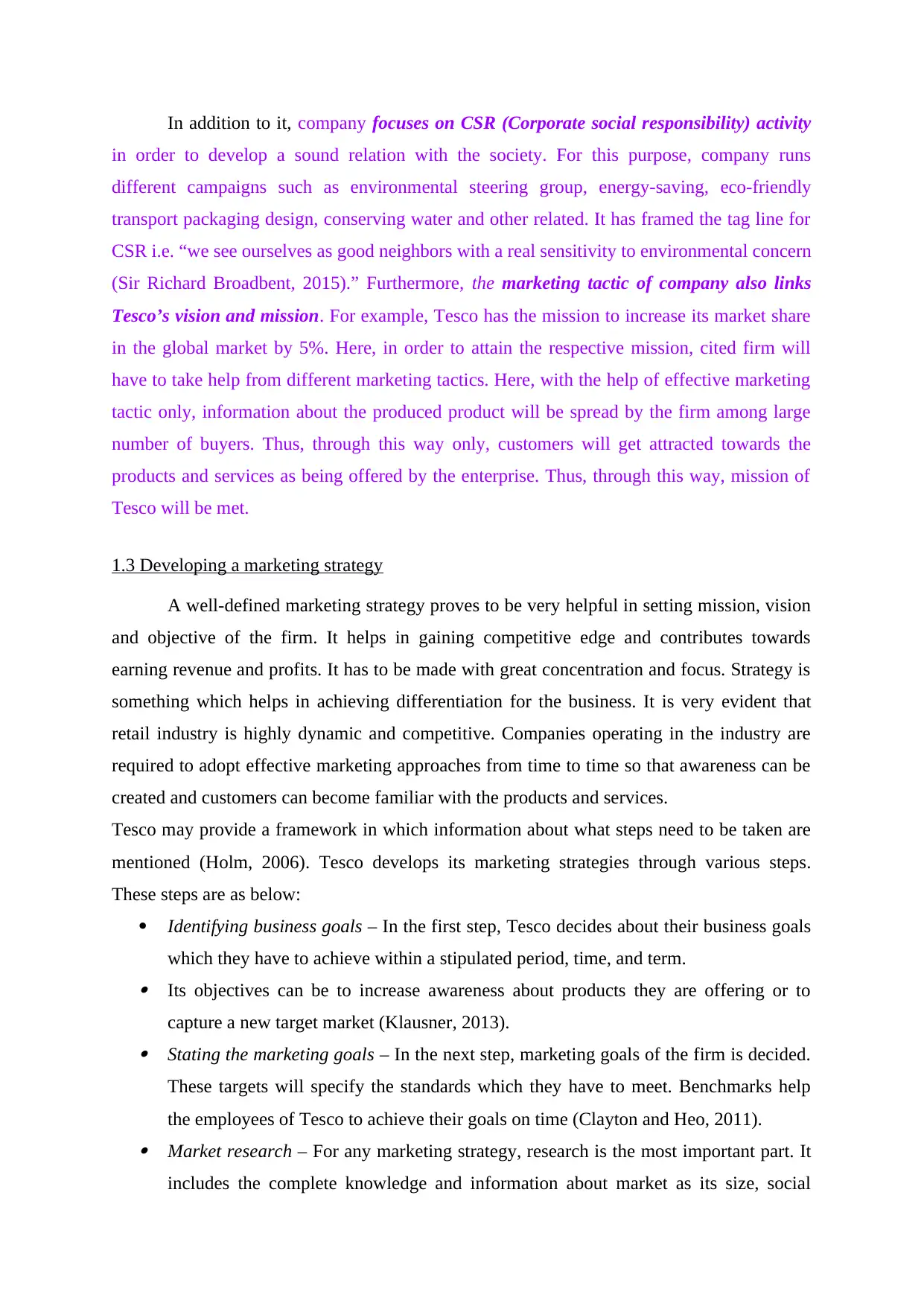
In addition to it, company focuses on CSR (Corporate social responsibility) activity
in order to develop a sound relation with the society. For this purpose, company runs
different campaigns such as environmental steering group, energy-saving, eco-friendly
transport packaging design, conserving water and other related. It has framed the tag line for
CSR i.e. “we see ourselves as good neighbors with a real sensitivity to environmental concern
(Sir Richard Broadbent, 2015).” Furthermore, the marketing tactic of company also links
Tesco’s vision and mission. For example, Tesco has the mission to increase its market share
in the global market by 5%. Here, in order to attain the respective mission, cited firm will
have to take help from different marketing tactics. Here, with the help of effective marketing
tactic only, information about the produced product will be spread by the firm among large
number of buyers. Thus, through this way only, customers will get attracted towards the
products and services as being offered by the enterprise. Thus, through this way, mission of
Tesco will be met.
1.3 Developing a marketing strategy
A well-defined marketing strategy proves to be very helpful in setting mission, vision
and objective of the firm. It helps in gaining competitive edge and contributes towards
earning revenue and profits. It has to be made with great concentration and focus. Strategy is
something which helps in achieving differentiation for the business. It is very evident that
retail industry is highly dynamic and competitive. Companies operating in the industry are
required to adopt effective marketing approaches from time to time so that awareness can be
created and customers can become familiar with the products and services.
Tesco may provide a framework in which information about what steps need to be taken are
mentioned (Holm, 2006). Tesco develops its marketing strategies through various steps.
These steps are as below:
Identifying business goals – In the first step, Tesco decides about their business goals
which they have to achieve within a stipulated period, time, and term. Its objectives can be to increase awareness about products they are offering or to
capture a new target market (Klausner, 2013). Stating the marketing goals – In the next step, marketing goals of the firm is decided.
These targets will specify the standards which they have to meet. Benchmarks help
the employees of Tesco to achieve their goals on time (Clayton and Heo, 2011). Market research – For any marketing strategy, research is the most important part. It
includes the complete knowledge and information about market as its size, social
in order to develop a sound relation with the society. For this purpose, company runs
different campaigns such as environmental steering group, energy-saving, eco-friendly
transport packaging design, conserving water and other related. It has framed the tag line for
CSR i.e. “we see ourselves as good neighbors with a real sensitivity to environmental concern
(Sir Richard Broadbent, 2015).” Furthermore, the marketing tactic of company also links
Tesco’s vision and mission. For example, Tesco has the mission to increase its market share
in the global market by 5%. Here, in order to attain the respective mission, cited firm will
have to take help from different marketing tactics. Here, with the help of effective marketing
tactic only, information about the produced product will be spread by the firm among large
number of buyers. Thus, through this way only, customers will get attracted towards the
products and services as being offered by the enterprise. Thus, through this way, mission of
Tesco will be met.
1.3 Developing a marketing strategy
A well-defined marketing strategy proves to be very helpful in setting mission, vision
and objective of the firm. It helps in gaining competitive edge and contributes towards
earning revenue and profits. It has to be made with great concentration and focus. Strategy is
something which helps in achieving differentiation for the business. It is very evident that
retail industry is highly dynamic and competitive. Companies operating in the industry are
required to adopt effective marketing approaches from time to time so that awareness can be
created and customers can become familiar with the products and services.
Tesco may provide a framework in which information about what steps need to be taken are
mentioned (Holm, 2006). Tesco develops its marketing strategies through various steps.
These steps are as below:
Identifying business goals – In the first step, Tesco decides about their business goals
which they have to achieve within a stipulated period, time, and term. Its objectives can be to increase awareness about products they are offering or to
capture a new target market (Klausner, 2013). Stating the marketing goals – In the next step, marketing goals of the firm is decided.
These targets will specify the standards which they have to meet. Benchmarks help
the employees of Tesco to achieve their goals on time (Clayton and Heo, 2011). Market research – For any marketing strategy, research is the most important part. It
includes the complete knowledge and information about market as its size, social
⊘ This is a preview!⊘
Do you want full access?
Subscribe today to unlock all pages.

Trusted by 1+ million students worldwide
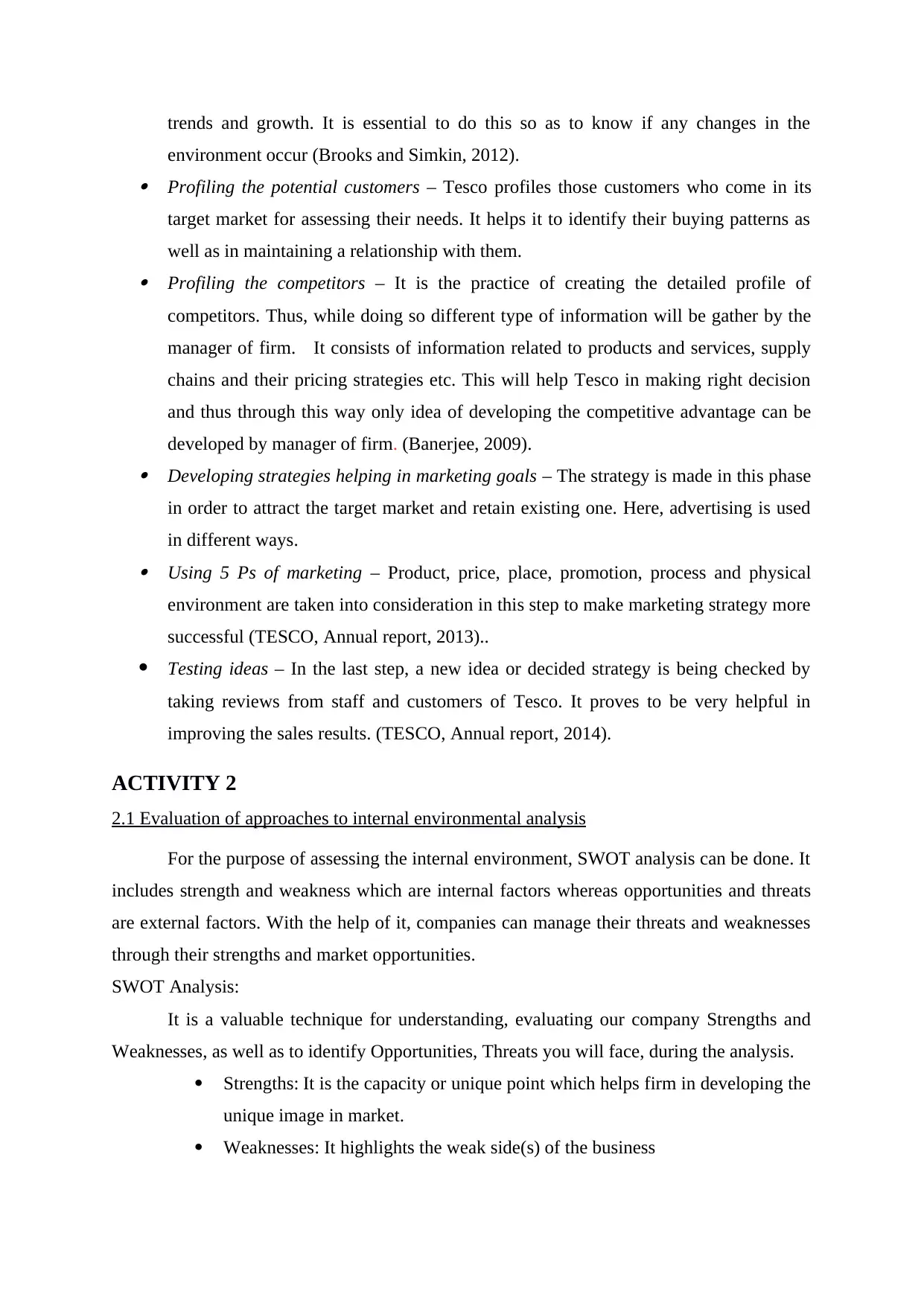
trends and growth. It is essential to do this so as to know if any changes in the
environment occur (Brooks and Simkin, 2012). Profiling the potential customers – Tesco profiles those customers who come in its
target market for assessing their needs. It helps it to identify their buying patterns as
well as in maintaining a relationship with them. Profiling the competitors – It is the practice of creating the detailed profile of
competitors. Thus, while doing so different type of information will be gather by the
manager of firm. It consists of information related to products and services, supply
chains and their pricing strategies etc. This will help Tesco in making right decision
and thus through this way only idea of developing the competitive advantage can be
developed by manager of firm. (Banerjee, 2009). Developing strategies helping in marketing goals – The strategy is made in this phase
in order to attract the target market and retain existing one. Here, advertising is used
in different ways. Using 5 Ps of marketing – Product, price, place, promotion, process and physical
environment are taken into consideration in this step to make marketing strategy more
successful (TESCO, Annual report, 2013)..
Testing ideas – In the last step, a new idea or decided strategy is being checked by
taking reviews from staff and customers of Tesco. It proves to be very helpful in
improving the sales results. (TESCO, Annual report, 2014).
ACTIVITY 2
2.1 Evaluation of approaches to internal environmental analysis
For the purpose of assessing the internal environment, SWOT analysis can be done. It
includes strength and weakness which are internal factors whereas opportunities and threats
are external factors. With the help of it, companies can manage their threats and weaknesses
through their strengths and market opportunities.
SWOT Analysis:
It is a valuable technique for understanding, evaluating our company Strengths and
Weaknesses, as well as to identify Opportunities, Threats you will face, during the analysis.
Strengths: It is the capacity or unique point which helps firm in developing the
unique image in market.
Weaknesses: It highlights the weak side(s) of the business
environment occur (Brooks and Simkin, 2012). Profiling the potential customers – Tesco profiles those customers who come in its
target market for assessing their needs. It helps it to identify their buying patterns as
well as in maintaining a relationship with them. Profiling the competitors – It is the practice of creating the detailed profile of
competitors. Thus, while doing so different type of information will be gather by the
manager of firm. It consists of information related to products and services, supply
chains and their pricing strategies etc. This will help Tesco in making right decision
and thus through this way only idea of developing the competitive advantage can be
developed by manager of firm. (Banerjee, 2009). Developing strategies helping in marketing goals – The strategy is made in this phase
in order to attract the target market and retain existing one. Here, advertising is used
in different ways. Using 5 Ps of marketing – Product, price, place, promotion, process and physical
environment are taken into consideration in this step to make marketing strategy more
successful (TESCO, Annual report, 2013)..
Testing ideas – In the last step, a new idea or decided strategy is being checked by
taking reviews from staff and customers of Tesco. It proves to be very helpful in
improving the sales results. (TESCO, Annual report, 2014).
ACTIVITY 2
2.1 Evaluation of approaches to internal environmental analysis
For the purpose of assessing the internal environment, SWOT analysis can be done. It
includes strength and weakness which are internal factors whereas opportunities and threats
are external factors. With the help of it, companies can manage their threats and weaknesses
through their strengths and market opportunities.
SWOT Analysis:
It is a valuable technique for understanding, evaluating our company Strengths and
Weaknesses, as well as to identify Opportunities, Threats you will face, during the analysis.
Strengths: It is the capacity or unique point which helps firm in developing the
unique image in market.
Weaknesses: It highlights the weak side(s) of the business
Paraphrase This Document
Need a fresh take? Get an instant paraphrase of this document with our AI Paraphraser
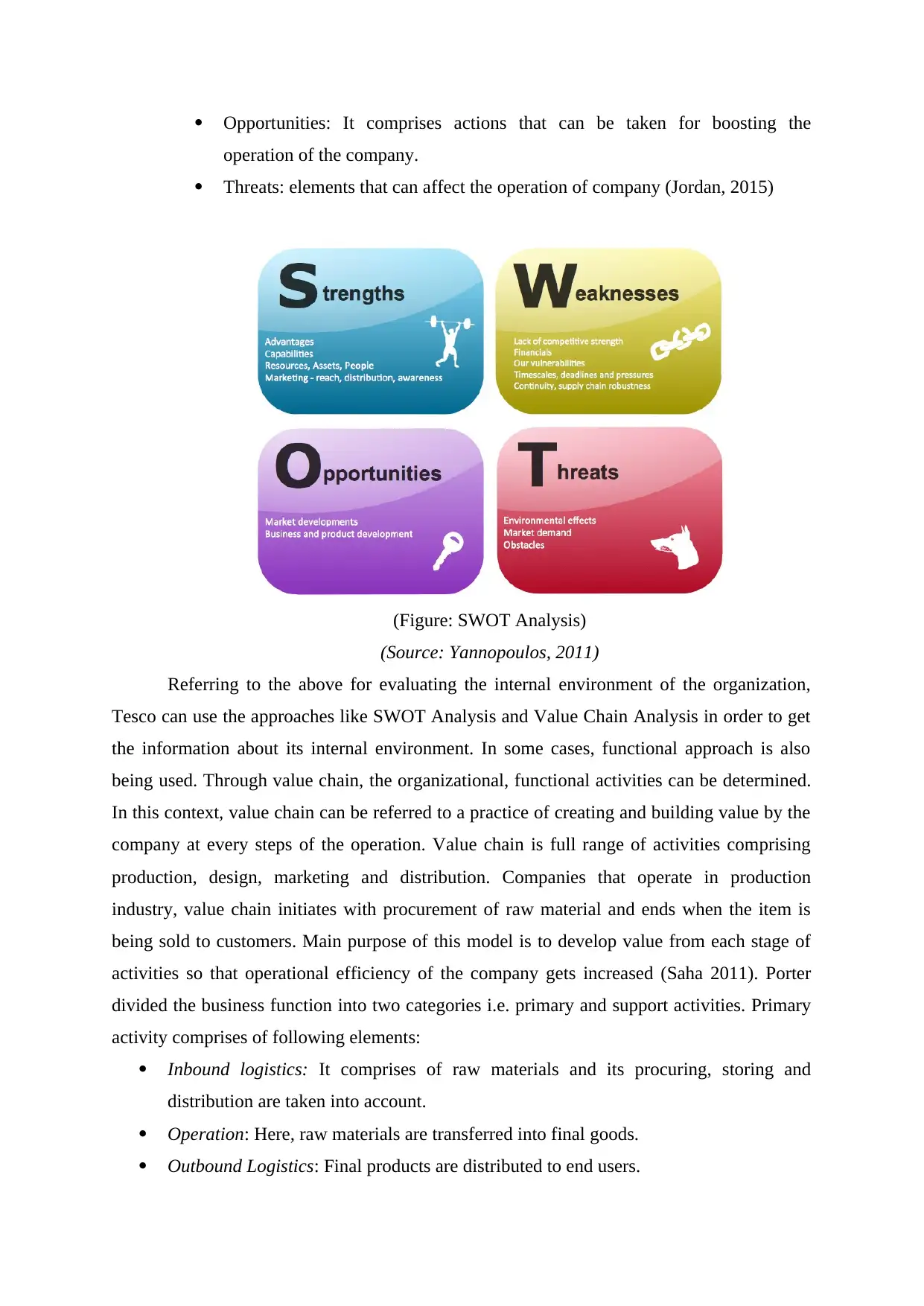
Opportunities: It comprises actions that can be taken for boosting the
operation of the company.
Threats: elements that can affect the operation of company (Jordan, 2015)
(Figure: SWOT Analysis)
(Source: Yannopoulos, 2011)
Referring to the above for evaluating the internal environment of the organization,
Tesco can use the approaches like SWOT Analysis and Value Chain Analysis in order to get
the information about its internal environment. In some cases, functional approach is also
being used. Through value chain, the organizational, functional activities can be determined.
In this context, value chain can be referred to a practice of creating and building value by the
company at every steps of the operation. Value chain is full range of activities comprising
production, design, marketing and distribution. Companies that operate in production
industry, value chain initiates with procurement of raw material and ends when the item is
being sold to customers. Main purpose of this model is to develop value from each stage of
activities so that operational efficiency of the company gets increased (Saha 2011). Porter
divided the business function into two categories i.e. primary and support activities. Primary
activity comprises of following elements:
Inbound logistics: It comprises of raw materials and its procuring, storing and
distribution are taken into account.
Operation: Here, raw materials are transferred into final goods.
Outbound Logistics: Final products are distributed to end users.
operation of the company.
Threats: elements that can affect the operation of company (Jordan, 2015)
(Figure: SWOT Analysis)
(Source: Yannopoulos, 2011)
Referring to the above for evaluating the internal environment of the organization,
Tesco can use the approaches like SWOT Analysis and Value Chain Analysis in order to get
the information about its internal environment. In some cases, functional approach is also
being used. Through value chain, the organizational, functional activities can be determined.
In this context, value chain can be referred to a practice of creating and building value by the
company at every steps of the operation. Value chain is full range of activities comprising
production, design, marketing and distribution. Companies that operate in production
industry, value chain initiates with procurement of raw material and ends when the item is
being sold to customers. Main purpose of this model is to develop value from each stage of
activities so that operational efficiency of the company gets increased (Saha 2011). Porter
divided the business function into two categories i.e. primary and support activities. Primary
activity comprises of following elements:
Inbound logistics: It comprises of raw materials and its procuring, storing and
distribution are taken into account.
Operation: Here, raw materials are transferred into final goods.
Outbound Logistics: Final products are distributed to end users.
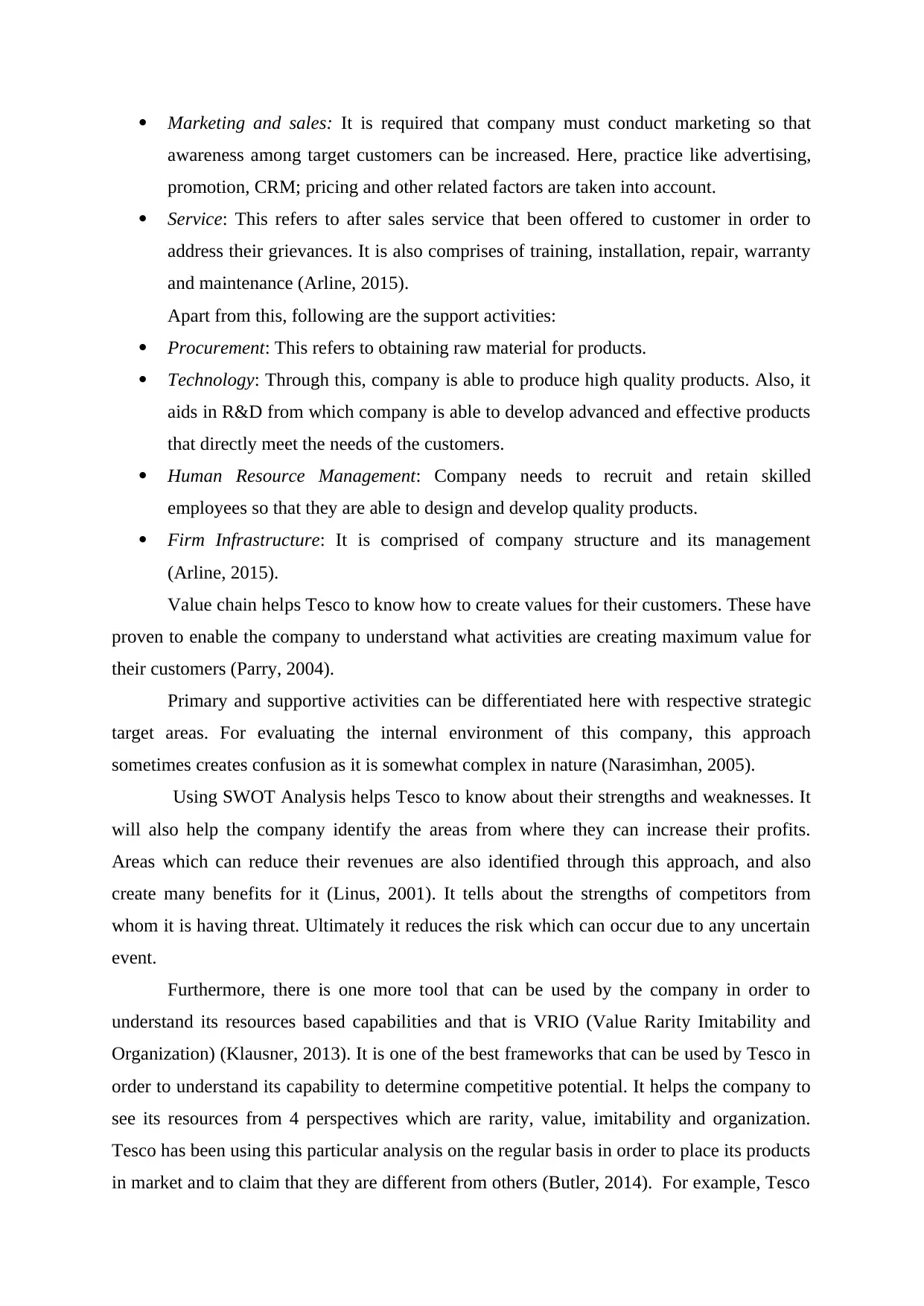
Marketing and sales: It is required that company must conduct marketing so that
awareness among target customers can be increased. Here, practice like advertising,
promotion, CRM; pricing and other related factors are taken into account.
Service: This refers to after sales service that been offered to customer in order to
address their grievances. It is also comprises of training, installation, repair, warranty
and maintenance (Arline, 2015).
Apart from this, following are the support activities:
Procurement: This refers to obtaining raw material for products.
Technology: Through this, company is able to produce high quality products. Also, it
aids in R&D from which company is able to develop advanced and effective products
that directly meet the needs of the customers.
Human Resource Management: Company needs to recruit and retain skilled
employees so that they are able to design and develop quality products.
Firm Infrastructure: It is comprised of company structure and its management
(Arline, 2015).
Value chain helps Tesco to know how to create values for their customers. These have
proven to enable the company to understand what activities are creating maximum value for
their customers (Parry, 2004).
Primary and supportive activities can be differentiated here with respective strategic
target areas. For evaluating the internal environment of this company, this approach
sometimes creates confusion as it is somewhat complex in nature (Narasimhan, 2005).
Using SWOT Analysis helps Tesco to know about their strengths and weaknesses. It
will also help the company identify the areas from where they can increase their profits.
Areas which can reduce their revenues are also identified through this approach, and also
create many benefits for it (Linus, 2001). It tells about the strengths of competitors from
whom it is having threat. Ultimately it reduces the risk which can occur due to any uncertain
event.
Furthermore, there is one more tool that can be used by the company in order to
understand its resources based capabilities and that is VRIO (Value Rarity Imitability and
Organization) (Klausner, 2013). It is one of the best frameworks that can be used by Tesco in
order to understand its capability to determine competitive potential. It helps the company to
see its resources from 4 perspectives which are rarity, value, imitability and organization.
Tesco has been using this particular analysis on the regular basis in order to place its products
in market and to claim that they are different from others (Butler, 2014). For example, Tesco
awareness among target customers can be increased. Here, practice like advertising,
promotion, CRM; pricing and other related factors are taken into account.
Service: This refers to after sales service that been offered to customer in order to
address their grievances. It is also comprises of training, installation, repair, warranty
and maintenance (Arline, 2015).
Apart from this, following are the support activities:
Procurement: This refers to obtaining raw material for products.
Technology: Through this, company is able to produce high quality products. Also, it
aids in R&D from which company is able to develop advanced and effective products
that directly meet the needs of the customers.
Human Resource Management: Company needs to recruit and retain skilled
employees so that they are able to design and develop quality products.
Firm Infrastructure: It is comprised of company structure and its management
(Arline, 2015).
Value chain helps Tesco to know how to create values for their customers. These have
proven to enable the company to understand what activities are creating maximum value for
their customers (Parry, 2004).
Primary and supportive activities can be differentiated here with respective strategic
target areas. For evaluating the internal environment of this company, this approach
sometimes creates confusion as it is somewhat complex in nature (Narasimhan, 2005).
Using SWOT Analysis helps Tesco to know about their strengths and weaknesses. It
will also help the company identify the areas from where they can increase their profits.
Areas which can reduce their revenues are also identified through this approach, and also
create many benefits for it (Linus, 2001). It tells about the strengths of competitors from
whom it is having threat. Ultimately it reduces the risk which can occur due to any uncertain
event.
Furthermore, there is one more tool that can be used by the company in order to
understand its resources based capabilities and that is VRIO (Value Rarity Imitability and
Organization) (Klausner, 2013). It is one of the best frameworks that can be used by Tesco in
order to understand its capability to determine competitive potential. It helps the company to
see its resources from 4 perspectives which are rarity, value, imitability and organization.
Tesco has been using this particular analysis on the regular basis in order to place its products
in market and to claim that they are different from others (Butler, 2014). For example, Tesco
⊘ This is a preview!⊘
Do you want full access?
Subscribe today to unlock all pages.

Trusted by 1+ million students worldwide
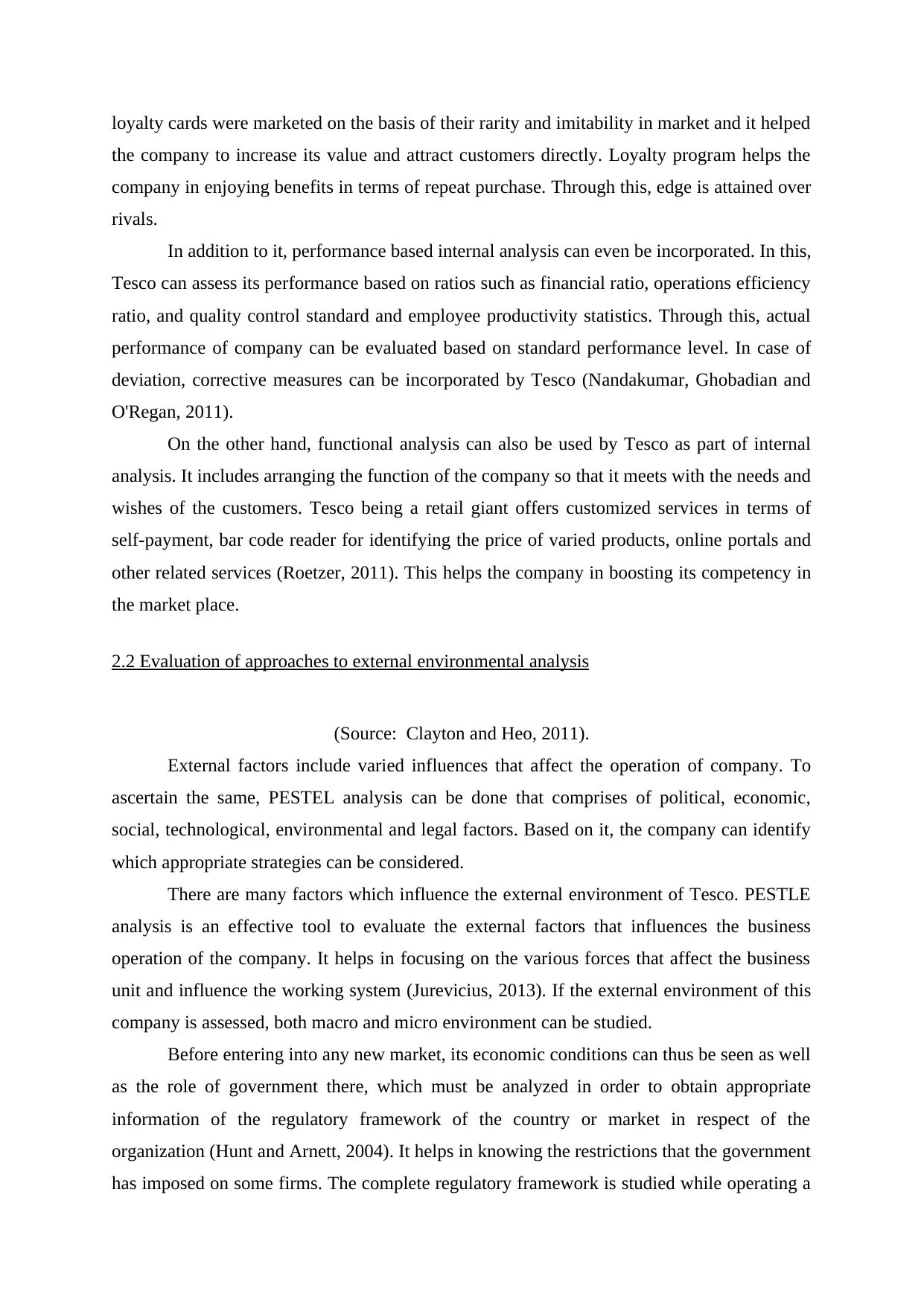
loyalty cards were marketed on the basis of their rarity and imitability in market and it helped
the company to increase its value and attract customers directly. Loyalty program helps the
company in enjoying benefits in terms of repeat purchase. Through this, edge is attained over
rivals.
In addition to it, performance based internal analysis can even be incorporated. In this,
Tesco can assess its performance based on ratios such as financial ratio, operations efficiency
ratio, and quality control standard and employee productivity statistics. Through this, actual
performance of company can be evaluated based on standard performance level. In case of
deviation, corrective measures can be incorporated by Tesco (Nandakumar, Ghobadian and
O'Regan, 2011).
On the other hand, functional analysis can also be used by Tesco as part of internal
analysis. It includes arranging the function of the company so that it meets with the needs and
wishes of the customers. Tesco being a retail giant offers customized services in terms of
self-payment, bar code reader for identifying the price of varied products, online portals and
other related services (Roetzer, 2011). This helps the company in boosting its competency in
the market place.
2.2 Evaluation of approaches to external environmental analysis
(Source: Clayton and Heo, 2011).
External factors include varied influences that affect the operation of company. To
ascertain the same, PESTEL analysis can be done that comprises of political, economic,
social, technological, environmental and legal factors. Based on it, the company can identify
which appropriate strategies can be considered.
There are many factors which influence the external environment of Tesco. PESTLE
analysis is an effective tool to evaluate the external factors that influences the business
operation of the company. It helps in focusing on the various forces that affect the business
unit and influence the working system (Jurevicius, 2013). If the external environment of this
company is assessed, both macro and micro environment can be studied.
Before entering into any new market, its economic conditions can thus be seen as well
as the role of government there, which must be analyzed in order to obtain appropriate
information of the regulatory framework of the country or market in respect of the
organization (Hunt and Arnett, 2004). It helps in knowing the restrictions that the government
has imposed on some firms. The complete regulatory framework is studied while operating a
the company to increase its value and attract customers directly. Loyalty program helps the
company in enjoying benefits in terms of repeat purchase. Through this, edge is attained over
rivals.
In addition to it, performance based internal analysis can even be incorporated. In this,
Tesco can assess its performance based on ratios such as financial ratio, operations efficiency
ratio, and quality control standard and employee productivity statistics. Through this, actual
performance of company can be evaluated based on standard performance level. In case of
deviation, corrective measures can be incorporated by Tesco (Nandakumar, Ghobadian and
O'Regan, 2011).
On the other hand, functional analysis can also be used by Tesco as part of internal
analysis. It includes arranging the function of the company so that it meets with the needs and
wishes of the customers. Tesco being a retail giant offers customized services in terms of
self-payment, bar code reader for identifying the price of varied products, online portals and
other related services (Roetzer, 2011). This helps the company in boosting its competency in
the market place.
2.2 Evaluation of approaches to external environmental analysis
(Source: Clayton and Heo, 2011).
External factors include varied influences that affect the operation of company. To
ascertain the same, PESTEL analysis can be done that comprises of political, economic,
social, technological, environmental and legal factors. Based on it, the company can identify
which appropriate strategies can be considered.
There are many factors which influence the external environment of Tesco. PESTLE
analysis is an effective tool to evaluate the external factors that influences the business
operation of the company. It helps in focusing on the various forces that affect the business
unit and influence the working system (Jurevicius, 2013). If the external environment of this
company is assessed, both macro and micro environment can be studied.
Before entering into any new market, its economic conditions can thus be seen as well
as the role of government there, which must be analyzed in order to obtain appropriate
information of the regulatory framework of the country or market in respect of the
organization (Hunt and Arnett, 2004). It helps in knowing the restrictions that the government
has imposed on some firms. The complete regulatory framework is studied while operating a
Paraphrase This Document
Need a fresh take? Get an instant paraphrase of this document with our AI Paraphraser
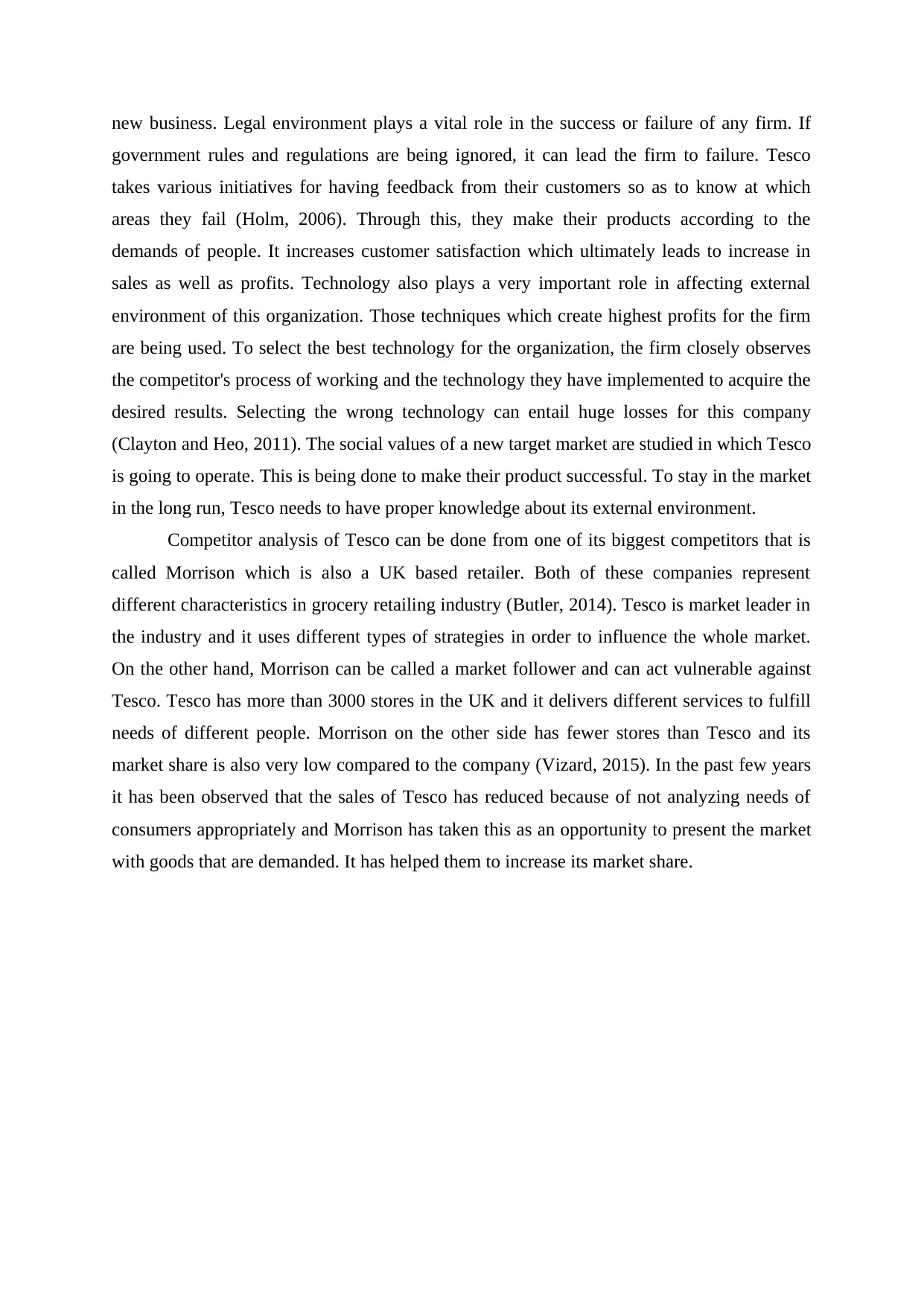
new business. Legal environment plays a vital role in the success or failure of any firm. If
government rules and regulations are being ignored, it can lead the firm to failure. Tesco
takes various initiatives for having feedback from their customers so as to know at which
areas they fail (Holm, 2006). Through this, they make their products according to the
demands of people. It increases customer satisfaction which ultimately leads to increase in
sales as well as profits. Technology also plays a very important role in affecting external
environment of this organization. Those techniques which create highest profits for the firm
are being used. To select the best technology for the organization, the firm closely observes
the competitor's process of working and the technology they have implemented to acquire the
desired results. Selecting the wrong technology can entail huge losses for this company
(Clayton and Heo, 2011). The social values of a new target market are studied in which Tesco
is going to operate. This is being done to make their product successful. To stay in the market
in the long run, Tesco needs to have proper knowledge about its external environment.
Competitor analysis of Tesco can be done from one of its biggest competitors that is
called Morrison which is also a UK based retailer. Both of these companies represent
different characteristics in grocery retailing industry (Butler, 2014). Tesco is market leader in
the industry and it uses different types of strategies in order to influence the whole market.
On the other hand, Morrison can be called a market follower and can act vulnerable against
Tesco. Tesco has more than 3000 stores in the UK and it delivers different services to fulfill
needs of different people. Morrison on the other side has fewer stores than Tesco and its
market share is also very low compared to the company (Vizard, 2015). In the past few years
it has been observed that the sales of Tesco has reduced because of not analyzing needs of
consumers appropriately and Morrison has taken this as an opportunity to present the market
with goods that are demanded. It has helped them to increase its market share.
government rules and regulations are being ignored, it can lead the firm to failure. Tesco
takes various initiatives for having feedback from their customers so as to know at which
areas they fail (Holm, 2006). Through this, they make their products according to the
demands of people. It increases customer satisfaction which ultimately leads to increase in
sales as well as profits. Technology also plays a very important role in affecting external
environment of this organization. Those techniques which create highest profits for the firm
are being used. To select the best technology for the organization, the firm closely observes
the competitor's process of working and the technology they have implemented to acquire the
desired results. Selecting the wrong technology can entail huge losses for this company
(Clayton and Heo, 2011). The social values of a new target market are studied in which Tesco
is going to operate. This is being done to make their product successful. To stay in the market
in the long run, Tesco needs to have proper knowledge about its external environment.
Competitor analysis of Tesco can be done from one of its biggest competitors that is
called Morrison which is also a UK based retailer. Both of these companies represent
different characteristics in grocery retailing industry (Butler, 2014). Tesco is market leader in
the industry and it uses different types of strategies in order to influence the whole market.
On the other hand, Morrison can be called a market follower and can act vulnerable against
Tesco. Tesco has more than 3000 stores in the UK and it delivers different services to fulfill
needs of different people. Morrison on the other side has fewer stores than Tesco and its
market share is also very low compared to the company (Vizard, 2015). In the past few years
it has been observed that the sales of Tesco has reduced because of not analyzing needs of
consumers appropriately and Morrison has taken this as an opportunity to present the market
with goods that are demanded. It has helped them to increase its market share.
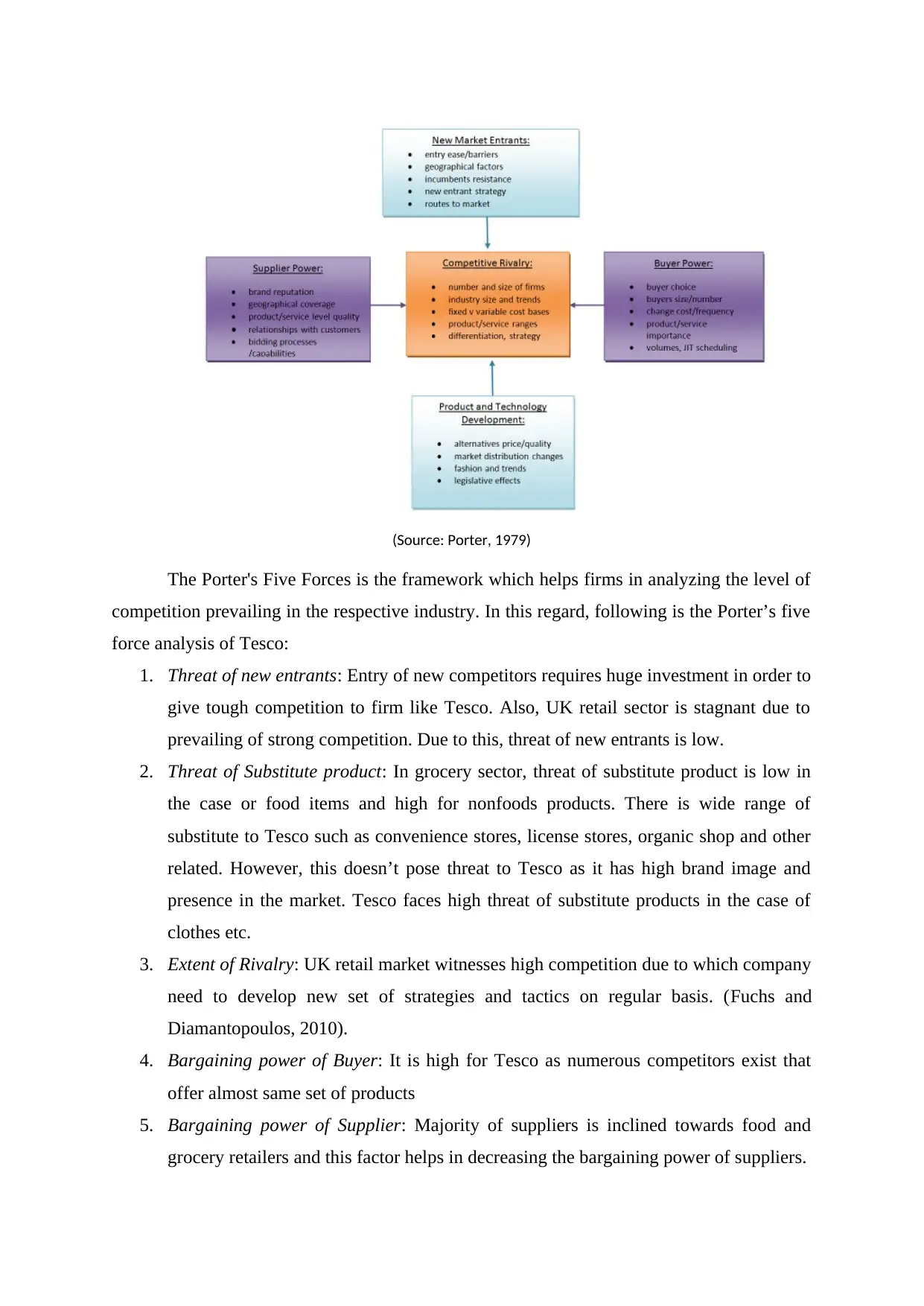
(Source: Porter, 1979)
The Porter's Five Forces is the framework which helps firms in analyzing the level of
competition prevailing in the respective industry. In this regard, following is the Porter’s five
force analysis of Tesco:
1. Threat of new entrants: Entry of new competitors requires huge investment in order to
give tough competition to firm like Tesco. Also, UK retail sector is stagnant due to
prevailing of strong competition. Due to this, threat of new entrants is low.
2. Threat of Substitute product: In grocery sector, threat of substitute product is low in
the case or food items and high for nonfoods products. There is wide range of
substitute to Tesco such as convenience stores, license stores, organic shop and other
related. However, this doesn’t pose threat to Tesco as it has high brand image and
presence in the market. Tesco faces high threat of substitute products in the case of
clothes etc.
3. Extent of Rivalry: UK retail market witnesses high competition due to which company
need to develop new set of strategies and tactics on regular basis. (Fuchs and
Diamantopoulos, 2010).
4. Bargaining power of Buyer: It is high for Tesco as numerous competitors exist that
offer almost same set of products
5. Bargaining power of Supplier: Majority of suppliers is inclined towards food and
grocery retailers and this factor helps in decreasing the bargaining power of suppliers.
The Porter's Five Forces is the framework which helps firms in analyzing the level of
competition prevailing in the respective industry. In this regard, following is the Porter’s five
force analysis of Tesco:
1. Threat of new entrants: Entry of new competitors requires huge investment in order to
give tough competition to firm like Tesco. Also, UK retail sector is stagnant due to
prevailing of strong competition. Due to this, threat of new entrants is low.
2. Threat of Substitute product: In grocery sector, threat of substitute product is low in
the case or food items and high for nonfoods products. There is wide range of
substitute to Tesco such as convenience stores, license stores, organic shop and other
related. However, this doesn’t pose threat to Tesco as it has high brand image and
presence in the market. Tesco faces high threat of substitute products in the case of
clothes etc.
3. Extent of Rivalry: UK retail market witnesses high competition due to which company
need to develop new set of strategies and tactics on regular basis. (Fuchs and
Diamantopoulos, 2010).
4. Bargaining power of Buyer: It is high for Tesco as numerous competitors exist that
offer almost same set of products
5. Bargaining power of Supplier: Majority of suppliers is inclined towards food and
grocery retailers and this factor helps in decreasing the bargaining power of suppliers.
⊘ This is a preview!⊘
Do you want full access?
Subscribe today to unlock all pages.

Trusted by 1+ million students worldwide
1 out of 27
Related Documents
Your All-in-One AI-Powered Toolkit for Academic Success.
+13062052269
info@desklib.com
Available 24*7 on WhatsApp / Email
![[object Object]](/_next/static/media/star-bottom.7253800d.svg)
Unlock your academic potential
Copyright © 2020–2025 A2Z Services. All Rights Reserved. Developed and managed by ZUCOL.





